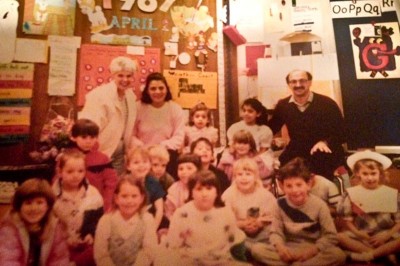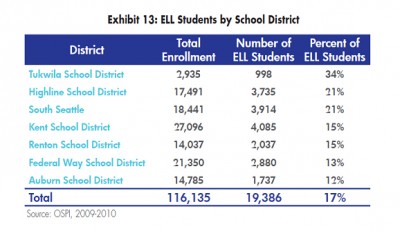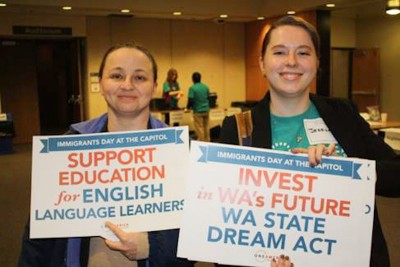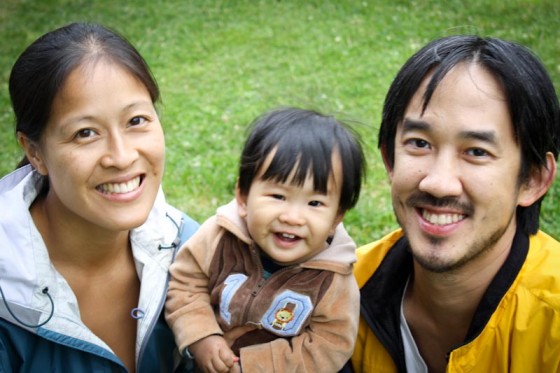King County school districts are stepping up and recognizing that immigrant students’ native language skills are a benefit, not a burden.
Growing up as a first generation American, my parents didn’t always agree on what language I should be learning.
My father, who came to the U.S. as a college student, was convinced that assimilation to American culture was the key to success. Like many other immigrants, he saw abandoning our native language, Farsi, as part of the price we had to pay to be successful Americans.
Conversely, my newly arrived mother had a strong conviction that learning my language of origin was vital if I was going to grow up with a positive cultural identity.
In the end, she prevailed, and took advantage of that slim window of time when a child has an innate capacity to learn two languages simultaneously. By kindergarten I was proficient in both Farsi and English.
Before I started school, my mom sat me down and explained that I need to be proud of my ability to speak Farsi and English and to tell my teachers and friends that being “bilingual” made me unique.

In fact, “bilingual” was one of the first complex English vocabulary words I mastered.
But when I went into first grade, my teacher had a different perspective. She quickly decided that knowledge of my home language was not only a deficit, but also grounds for removing me from my elementary school and transferring me to a school for English as a Second Language (ESL) students.
As soon as my parents caught wind of this they marched down to the school and demanded that I remain in my current first grade classroom. Though their intervention was successful, my mother instantly doubted her decision to teach me Farsi, while my father reinforced the importance of English mastery for academic success.
I spent the remainder of my school years wavering between shame and pride around my identity and language. I soon learned to separate who I was at home from who I was at school, realizing that if I wanted to be successful academically, the two worlds shouldn’t mix.
Looking back, I know that this ability to “code switch” (and my parent’s strong advocacy) ultimately set me on a positive academic trajectory and probably saved me from falling victim to the growing opportunity or achievement gap for students of color.
Today in Washington State, only about fifty percent of English Language Learner (ELL) students complete high school. For subgroups like Latinos and Pacific Islanders the high school completion rate is even lower. By comparison, 78% percent of students in the state overall graduate.
Working for the past two years in the education policy realm, I have heard many theories that explain this gap — everything from poverty, to high student to teacher ratios and under-funding of education.
While these are all valid, based on my personal experience, I know that when students are not encouraged to embrace all of their strengths, including being bilingual and bicultural, they can feel alienated from the school environment, and sometimes detach from education entirely.

This is especially relevant in South King County where the student population is one of the most diverse in the nation, speaking over 160 different primary languages, and the disparities are vast.
So when The Road Map Project, a collective action, cradle-to-career initiative, launched in 2010 with the aim of closing the achievement gap for low income students and students of color in South King County, a huge emphasis was placed on the needs of English Language Learners (ELL).
The project partnered with OneAmerica, the immigrant rights organization I currently work for, and I was tasked with leading a team of experts through developing an action plan to improve the education system regionally for English Language Learners.
Anxious to figure out how we could foster positive identity and primary language development, I searched for examples of schools embracing the value of bilingualism and the immigrant experience.
What I found was an existing program, spearheaded by Bernard Knootz in the Highline School District and later replicated by Veronica Gallardo in the Seattle School District that allows students who are fluent in their native language to earn high school language credits for those existing language skills.
The students simply take a proficiency test, offered in any language, and if they score high enough they can even bypass the foreign language credit requirement necessary for college entrance.
The program simultaneously recognizes the value of native language skills and improves graduation and college attendance rates for ELL students by allowing them to earn missing credits.

Last year, a collaboration of school districts, community based organizations and the state Office of Superindent of Public Instruction came together to expand the program to the South King County region.
It wasn’t easy. Advocates had to convince their local school boards to pass policies and procedures to allow students to earn the credits, districts had to reconfigure their funding streams to support the testing, and school staff had to be trained to administer the program.
Through the courageous leadership and hard work of the group members, along with a generous grant from the Gates Foundation, in the 2012-13 school year the World Language Credit Program successfully overcame these hurdles and expanded to all seven South King County School Districts.
The program doubled its goals and expectations with more than 1000 students earning credits in over 30 different languages, including languages like Burmese, Hmong, and Haitian-Creole.
The outpouring of students signing up to take the exam was not only surprising to many districts, but also signaled the number of fully bilingual and biliterate students in each district.
Student report backs that were gathered anonymously to evaluate the impact of the program reflected the positive impact:
One high school student who benefited from the program said, “I am extremely excited because I have never gotten the chance to put my language to use at school or to something that will benefit me in the future.”
“Having an opportunity where cultural skills learned outside of school are recognized is fantastic!” another student reported.
Similarly, immigrant parents have expressed that after seeing the academic benefits of speaking the home language, they feel more supported and validated in the assets they bring to their children’s educational experiences.
Due to the program’s success, leaders in the state have vowed to pass a Seal of Biliteracy in the 2014 state legislative session, which will add additional prestige and value to earning the four language credits. Schools are looking to partner with culturally responsive community-based organizations and parents to tutor students in their primary language so they can improve their skills and earn the maximum number of credits.

Districts like Highline Public Schools in Burien have taken their commitment one step further, stating in their strategic plan that every student, including English-only speakers, will graduate bilingual and biliterate by 2026.
For me, it wasn’t until recently that I realized the ways in which bilingualism has positively impacted my life: my knack for language acquisition, increased marketability for jobs and higher education, skills to travel the world while relating to various cultures and most importantly, the connection to my country of origin, history, and family — especially elders in my community.
If programs like the World Language Credit existed when I was in school would my mother have felt more supported in her beliefs around the benefits of being bilingual? Would my father have thought differently about the need to ‘give up’ the home language to be successful? Would I have been less compelled to leave an important part of my identity outside the classroom doors?
I will never know the answers for sure. But what I do know is that cultivating a generation of students who are bilingual not only gives our students a sense of pride in who they are and where they come from, it also makes them more deeply connected to their educational success and grows the global competitiveness of our region.



Thank you so much for Roxana for shedding a light on this important issue and for sharing your own personal experience. Here’s hoping to have World Language Credit become a reality soon!
Very interesting to read how your experience connects with issues we are currently working to address. Hope we continue to take steps forward- informative articles like this will help advocates come together to move in that direction!
When it comes from the heart, it sits on the heart.
This is what I have noticed with Ms. Norouzi’s articles.
Informative and enjoyable.
Looking forward to more of your good work.
Another great article from Roxana. We all immigrant and our children experience this and it is so nice that a great author express those words in writing so clearly. Great job Roxana and thanks for sharing your experience and all the important information. Looking forward to more of your great writing.
Impressive and enlightening. Thank you.